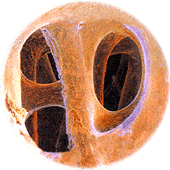 |
| Normal bone: the bone density and calcium content will reach its peak in young adulthood. |
Osteoporosis is a debilitating condition of skeletal fragility that predominantly affects women and is particularly common in the elderly. It is a metabolic bone disease characterized by a parallel reduction in bone mineral density and bone matrix, leading to deterioration of the micro-architecture of bone tissue and impairment of the structural integrity of trabecular bone (the inner part of bone that consists of a meshwork of bony bars with numerous interconnecting spaces containing marrow). The consequence is that although the bone tissue has normal composition and proper mineralization, the bone mass (density) is reduced and the bone becomes more fragile. To establish a diagnosis of osteoporosis, the individual bone mineral density is compared with the peak bone mass measurement in the healthy young adult. This comparison is made by means of standard deviation (SD) units (T scores). Clinically, a patient is said to suffer from osteoporosis if his/her bone density falls 2.5 SD below the mean of normally mineralized bone, calculated in comparison to age-, sex-, and race-matched controls (a T score of  2.5). For example, compared to standardized bone density measurements of the total hip of 2.5). For example, compared to standardized bone density measurements of the total hip of  833 mg/cm2, in osteoporosis, the same measurements will be lower than 648 mg/cm2 (World Health Organization). If not prevented or if left untreated, osteoporosis can progress painlessly until a bone breaks. Any bone can be affected, but of special concern are fractures of the hip and spine. A hip fracture almost always requires hospitalization and major surgery. It can impair the ability to walk unassisted and may cause prolonged or permanent disability, or even death. Spinal or vertebral fractures also have serious consequences, including loss of height, severe back pain and deformity. 833 mg/cm2, in osteoporosis, the same measurements will be lower than 648 mg/cm2 (World Health Organization). If not prevented or if left untreated, osteoporosis can progress painlessly until a bone breaks. Any bone can be affected, but of special concern are fractures of the hip and spine. A hip fracture almost always requires hospitalization and major surgery. It can impair the ability to walk unassisted and may cause prolonged or permanent disability, or even death. Spinal or vertebral fractures also have serious consequences, including loss of height, severe back pain and deformity.
Multiple etiologic factors of osteoporosis have been identified, which give the various disease types their names.
Statistics
Osteoporosis is a major public health concern that affects more than 28 million Americans, 80 per cent of whom are women. Women are more likely than men to develop osteoporosis because, as a group, they have lighter bones, less total calcium, and also lose bone at a rate three times greater than that of men. In the US today, 10 million individuals have the disease and 18 million more have low bone mass, placing them at increased risk for osteoporosis. Ten per cent of African-American women over the age of 50 years have osteoporosis; an additional 30 per cent have low bone density that puts them at risk of developing osteoporosis. Significant risk has been reported in people of all ethnic backgrounds.
The disease accounts for more than 1.5 million fractures per year in the US: one out of every four women by the age of 70 develops an osteoporotic fracture; and one in two women and one in eight men over the age of 50 will have an osteoporosis-related fracture in their lifetime. These fractures include the following (approximate figures):
 |
300,000 hip fractures |
 |
700,000 vertebral fractures |
 |
250,000 wrist fractures |
 |
300,000 fractures at other sites |
|